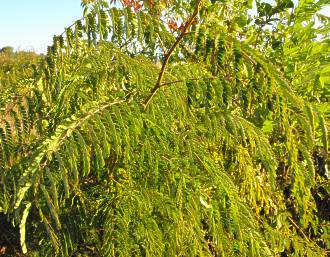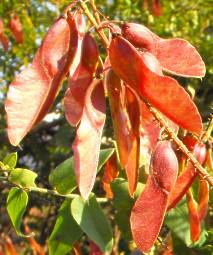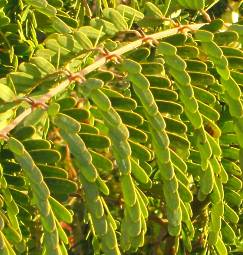Pterolobium stellatum
Pterolobium stellatum (Forssk.) Brenan
Family: Fabaceae
Common names: red-wing (Eng.); rooivlerk (Afr.); gwambazi or luanakha (Tshivenda)
Introduction
Pterolobium stellatum is a tall, scrambling or climbing shrub with woody rope-like stems.
Description
Description

Young plants are densely covered with hairs on stem and leaves. The stem has hooking prickles in pairs at the nodes and scattered ones between the nodes. Leaves are compound with 7-15 pairs of leaflets. The leaf axis is armed on the lower side with paired reflexed prickles. The flowers are small and sweetly scented with a pale yellowish-white colour. The seed pods are broadly winged with a red to scarlet colour when young, becoming brown with age. Flowering time is from March to May.

Conservation Status
Status
In South Africa this plant is not threatened as it is widely distributed in the Mpumalanga and Limpopo Provinces, especially in the Kruger National Park. The long term threat due to human settlement and climate change cannot be ruled out.
Distribution and habitat
Distribution description
Pterolobium stellatum occurs at forest margins and in riverine bush, woodland, often on termite mounds, and along rocky slopes. Widespread along the eastern half of Africa: Mpumalanga in the south and northwards to Ethiopia and the Sudan. This is the only species in Africa.
There are about 10 species of Pterolobium, naturally occurring in the tropical regions, with one species, Pterolobium stellatum, found in southern Africa.
Derivation of name and historical aspects
History
Pteron = a wing and lobium = fruit (Greek), alluding to the winged fruit; stellatum = starry, star-like (Latin); possibly alluding to the flowers.
Ecology
Ecology
This plant is usually covered in butterflies and bees during the flowering season. It is also highly favoured by wildlife for refuge as it can form impenetrable thickets.
Uses
Use
Pterolobium stellatum can be used for creating a barrier, commonly known in horticulture as screening. It is an ideal plant for big gardens. Indigenous people in rural areas grow this plant at the boundary of stands for fencing. It is commonly used around the cattle kraal for security reasons. It is often planted around the vegetable garden to protect the crops from domestic and wild animals.
This plant can easily be confused with Caesalpinia decapetala (the declared invasive alien Mauritius thorn). However, the exotic Caesalpinia decapetala has very different flowers and fruits. They are sometimes used simultaneously for the same purpose.

Growing Pterolobium stellatum
Grow
This plant can be propagated from seed. Seeds require pre-treatment to break the dormancy in order to enhance the rate of germination. They can be submerged in hot water for less than 2 minutes or roasted for 1 minute.
Pterolobium stellatum grows very well in red loam soil.
References
- Coates Palgrave, M. 2002. Keith Coates Palgrave Trees of southern Africa, edn 3. Struik, Cape Town.
- Fabian, A. & Germishuizen, G. 1997. Wildflowers of northern South Africa. Fernwood Press, Vlaeberg, Cape Town.
- Hyde, M.A. & Wursten, B. 2009. Flora of Zimbabwe: Species information: Pterolobium stellatum.
- Schmidt, E., Lötter, M. & McCleland, W. 2002. Trees and shrubs of Mpumalanga and Kruger National Park. Jacana, Johannesburg.
- Teketay, D. 1998. Germination of Acacia origena, A. pilispina and Pterolobium stellatumin response to different pre-sowing seed treatments, temperature and light. Journal of Arid Environments, Volume 38(4):pp. 551-560(10)
Credits
Thompson Mutshinyalo
Walter Sisulu National Botanical Garden
December 2009
Plant Attributes:
Plant Type: Shrub
SA Distribution: Limpopo, Mpumalanga
Soil type: Loam
Flowering season: Autumn
PH: Acid
Flower colour: Yellow
Aspect: Full Sun
Gardening skill: Average
Special Features:
Horticultural zones







Rate this article
Article well written and informative
Rate this plant
Is this an interesting plant?
Login to add your Comment
Back to topNot registered yet? Click here to register.